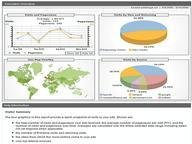Quiz Answer Key and Fun Facts
1. Combinatorics: Assume the balls are indistinguishable in all aspects except color. In an urn with 5 black balls and 3 white balls, how many ways can you pick 2 black balls and 1 white ball at once?
2. Definition of Probability: Which of the following statements about probability is INCORRECT?
3. Conditional Probability: There are four closed doors. Behind one of them is a car, and the other three are goats. You pick one door at random. The game host then opens two doors you didn't select that have goats behind each one. Now there are two doors unopened. The host then asks you whether you want to switch to the other unopened door. What is your probability of winning the car if you switch?
4. Discrete Random Variables: If X~Binomial(10,0.4), which of the following is true about the mean and variance of X?
5. Continuous Random Variables: If U~Uniform(0,1) and X~Exponential(1). Then
6. Joint Random Variables: Let f(x,y) be the joint probability mass function (PMF) or probability density function (PDF) of random variables X and Y. Let f(x) and f(y) be their marginal PMF/PDF, respectively. Then which of the following is true when X and Y are independent?
7. Conditional Expectation: If X|Y~Normal(2Y,3Y) and Y~Poisson(5). Find E(X).
8. Central Limit Theorem: Let X1,...,Xn be independent and identically distributed with Poisson(m). When n is large, what is the approximate distribution of ∑Xi, i=1,...,n?
9. Generating Functions: Which of the following statements is INCORRECT about the moment generating function (MGF)? For reference, MGFx(t) = E[exp(tX)].
10. Order Statistics: The minimum of n independently identically distributed (i.i.d.) Exponential(a) random variables has what distribution?
Source: Author
irving9918
This quiz was reviewed by FunTrivia editor
WesleyCrusher before going online.
Any errors found in FunTrivia content are routinely corrected through our feedback system.

